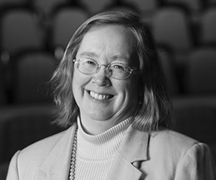
For many of us, the basement is sort of a merchandise purgatory, home to the items we don’t really use anymore but still can’t quite bring ourselves to throw out.
But when Susan Ohmer went digging through the basement of New York University’s library as a doctoral student, she came across something a little more valuable than rusting garden equipment or old issues of People magazine.
What she found – a four-reel microfilm set titled “Gallup Looks at the Movies” – detailed how George Gallup, whose last name is today synonymous with opinion polling, pioneered audience research in Hollywood during the 1930s and ’40s. His techniques guide moviemakers to this day.
Ohmer’s find became a scholar’s Eureka moment.
“I woke up in the middle of the night, and I said: `Thousands of pages of stuff that nobody knows about, and it’s George Gallup?’” said Ohmer, the William T. and Helen Kuhn Carey Assistant Professor of Modern Communication at the University of Notre Dame.
Gallup’s involvement in the film industry became the focus of Ohmer’s dissertation, which won the Society for Cinema Studies Dissertation Award in 1998. This fall, her work will be published as a book, “George Gallup in Hollywood,” by Columbia University Press.
Gallup served from 1932-47 as director of research at the advertising firm Young & Rubicam, where Ohmer says he began to develop his polling techniques. He first put his methods on public display in the months leading up to the 1936 presidential election, when, against popular opinion and a popular magazine of the day, the Literary Digest, he predicted a win for Franklin D. Roosevelt.
“He actually made a national challenge in the pages of the Washington Post,” Ohmer said. “In the July before the election, he did a pilot survey mimicking the Digest, and he said: `This is what the Digest will tell you that will happen. This is why they are wrong, and I am going to take them on.’”
Gallup’s poll said Roosevelt would win reelection, while the Literary Digest – which had mailed more than 10 million questionnaires and received a huge 2.3 million-person response – claimed it would be Alf Landon by a wide margin.
Within three months of Roosevelt’s victory, the Literary Digest was out of business, and, in the process, a star was born.
“That made him so famous that Hollywood picked up on it,” Ohmer said.
Gallup didn’t pursue this information in isolation from his political queries, Ohmer found. Rather, questions about things like voting habits and double features could be found in the same poll.
Many of the techniques Gallup developed for audience research are still used in some form today, the most prevalent of which is the invitational preview. In this arrangement, people from the target demographic group are invited to an advanced screening of a film and asked to complete questionnaires about what they liked or disliked.
Ohmer says that like Gallup’s polls, modern surveys frequently seek to determine what should be emphasized in the film’s advertising and which scenes should be cut. Gallup often took the process a step further, adapting a dial device created for radio that allowed the audience to register their opinions on each scene as they viewed the film. Such audience devices are still used in television today.
The way Gallup’s work affected Hollywood and revolutionized moviemaking is perhaps nowhere more apparent than in the case of America’s favorite cartoon kingdom. Disney subjected every film it made from 1946-52 to a Gallup preview.
In writing her book, Ohmer talked with the animators on “Fantasia” and “Cinderella,” who were angered by what they felt was Disney using Gallup’s tools to boil their creative work down to “enjoyment rankings.”
_*Contact:* Susan Ohmer, 574-631-7671 or sohmer@nd.edu
_
Originally published by at newsinfo.nd.edu on June 29, 2006.